
The Application Notebook
Solid phase microextraction (SPME) is a well established sampling technique that is often used to isolate volatile organic components in gaseous mixtures.

The Application Notebook
Solid phase microextraction (SPME) is a well established sampling technique that is often used to isolate volatile organic components in gaseous mixtures.

The Application Notebook
Phenols are frequently present in water because of their widespread use in commercial products and because they are by-products of processes in petrochemical, pulp and paper, plastic, and glue manufacturing industries (1,2). The concentration of phenolic compounds in the waste discharges can be as high as 20 mg/L (2); however, phenol-containing pesticides and wood preservatives may cause significant health hazards even at mg/L levels (1). Consequently, it is important to monitor phenols and substituted phenols in environmental and biological samples. Liquid chromatography with electrochemical detection is one of the widely used methods due to its high selectivity and sensitivity for phenolic compounds. However, glassy carbon working electrodes, used in the electrochemical detection of phenols, often require polishing (3). This time-consuming and often poorly reproducible polishing can be avoided with disposable carbon electrodes, which offer comparable or better analytical performance (4).
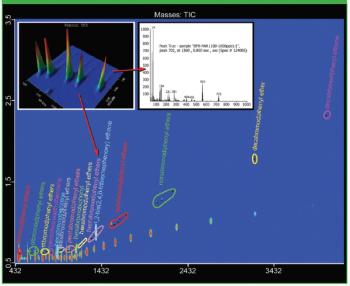
The Application Notebook
Polybrominated diphenyl ethers (PBDE) are persistent environmental contaminants that are being extensively studied by environmental researchers worldwide. Their potential for toxicological impacts on humans and wildlife has made them a focal point of regulatory agencies. Their widespread use as flame retardants in electronics, household furniture, and many other building materials has lead to a need for analysis of many different sample matrices, including very complex environmental samples.
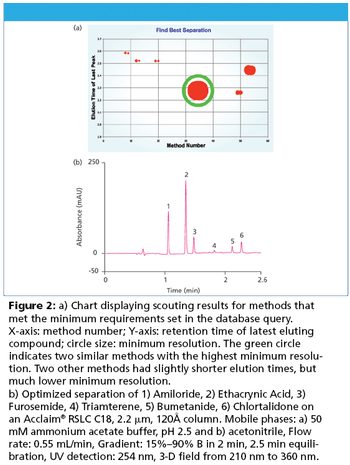
The Application Notebook
In HPLC method development, screening of various para-meters such as stationary phase, eluents, and temperatures is conducted to find optimal resolution. However, method development can be a time consuming and inefficient process. UHPLC technology can be applied to significantly shorten both the analysis and development times. Here we describe an integrated and ultrafast automated method scouting solution that provides fast and efficient method development processes.
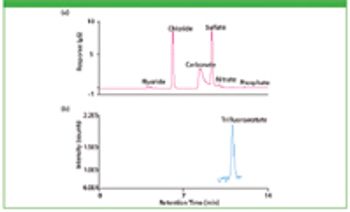
The Application Notebook
Perflourinated organic acids are ubiquitous and found at relatively low concentrations in the environment (1). Trifluoroacetic acid (TFA) is the persistent atmospheric degradation product of hydrofluorocarbons (HFCs) that are increasingly used as an alternative to banned, ozone-damaging chlorofluorocarbons (CFCs). However, debate surrounds the use of HFCs because of their potential to contribute to global warming and demonstrated toxicity to the environment (2). TFA is also widely used in pharmaceutical and biotechnology purification processes. It is crucial to monitor for TFA in environmental risk assessment and in products intended for human use. TFA can be measured by gas chromatography (GC) after sample preparation and chemical derivatization (3), ion chromatography (IC) (4), and capillary electrophoresis (5). This paper describes an IC-MS method to separate TFA from common anions based on Reagent-Freeâ„¢ IC (RFICâ„¢) technology with sensitive and selective mass spectrometric detection.

The Application Notebook
Gel Permeation Chromatography (GPC) is widely used for sample clean up in mycotoxin analysis. The most commonly described methods use GPC columns packed with SX-3 BioBeads suitable for cleaning Zearalenone, Aflatoxins, and Trichothesenes from edible oils and fatty matrices. Separation of Fumonisins from the oil fraction are inadequate with this column.
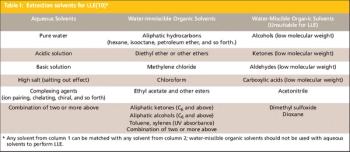
The Application Notebook
Columnist Ron Majors discusses some of the practical considerations in the successful application of the popular yet age-old technique of solvent extraction (also known as liquid–liquid extraction, or LLE). After a brief review of the basics, guidelines on the selection of the appropriate extraction solvents and how to use acid–base equilibria to ensure efficient extractions of ionic and ionizable compounds are provided. Problems in LLE and the solutions to these problems are highlighted. A newer technique called dispersive liquid–liquid microextraction is introduced.

The Application Notebook
The recent establishment of a 1 μg/g safety threshold for melamine in infant foods has led to an immediate need for more sensitive methods. Here we established GC–MS conditions for highly reproducible analyses and evaluated the effectiveness of both solvent-based and matrix-matched standards. Using this method, melamine and cyanuric acid were reliably detected at and below 1 μg/g in infant formula.
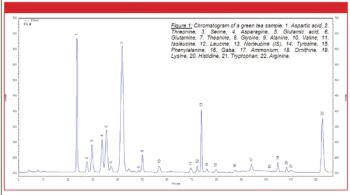
The Application Notebook
The Biochrom 30 Amino Acid Analyser is a well established analytical instrument for clinical diagnosis as its IVD approval allows the diagnosis of inborn errors of metabolism such as Phenylketonuria.

The Application Notebook
Thermal agility is a term that describes the ability of an oven to heat up and cool down. Both steps comprise the complete cycle time which, in turn, determines sample throughput. Fast GC accessories provide an attractive means of increasing sample throughput because they are easy to implement and deliver reliable performance at low cost. They require little or no bench space and do not incur additional costs for consumables and support equipment such as autosamplers, data acquisition software, and computers. Fast oven cooling is especially attractive because methods do not have to be re-validated since the separation parameters remain unchanged.

The Application Notebook
Achieve highly reproducible cIEF separations of basic mAbs using the basic pH gradient cIEF separation method on the PA 800 Protein Characterization System.

The Application Notebook
The chance to have everyone you might e-mail or call on the phone in one place makes this conference critical

The Application Notebook
Development of cephalosporin antibiotics has led to compounds with a broad spectrum of activity against both Gram-positive and Gram-negative bacteria with low toxicity profiles. Cefepime, a fourth-generation cephalosporin, is a commonly prescribed broad spectrum antibiotic with improved activity against Gram-negative bacteria compared to other commercially available cephalosporins (1). Despite extensive research on this class of drugs, quantitative analysis and purity assays remain problematic (2).

The Application Notebook
EPA Method 8260 is used to determine volatile organic compounds (VOC's) in a variety of matrices including ground and surface waters. This method is commonly used in environmental laboratories where gas chromatography (GC), mass spectrometry (MS) and purge and trap (P&T) technology are used for the analysis and subsequent detection of VOC's.
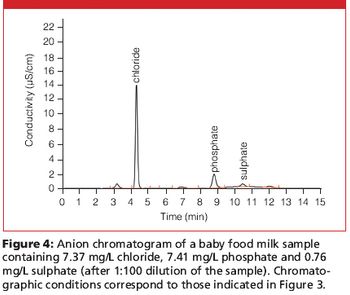
The Application Notebook
Run a difficult food sample on your IC and you stand a big chance that you will wreck the column. Of course, you can waste a lot of time on tedious sample preparation steps to eliminate undesired matrix components. Or you can go for Metrohm's automated compact stopped-flow dialysis providing optimum separation while protecting your column from detrimental compounds.
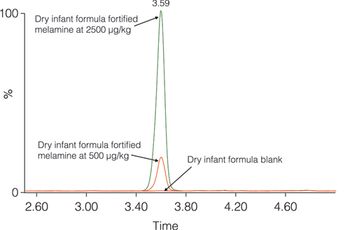
The Application Notebook
This method is rapid and sensitive for the analysis of melamine and cyanuric acid simultaneously in infant formula. Using two Oasis solid-phase extraction protocols and the ACQUITY UPLC, the results are consistent with the published US FDA interim method, while demonstrating a reduced analysis time.

The Application Notebook
Melamine is an industrial chemical with a high nitrogen content that can cause kidney stones and lead to renal failure. In some instances, melamine has been added to baby formula and dairy products as a substitute for protein. This paper presents an efficient and definitive gas chromatography–mass spectrometry (GC–MS) method to identify melamine and related compounds based on the released US Food and Drug Administration (FDA) method.
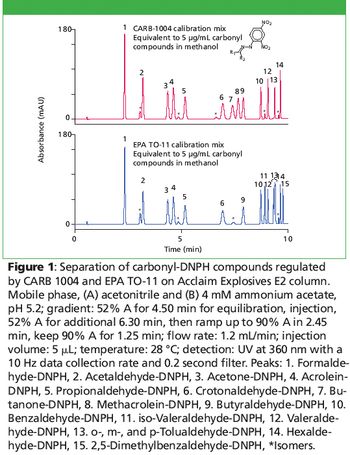
The Application Notebook
Carbonyl compounds, including low molecular weight aldehydes and ketones, have environmental and health concerns; for example, short-term exposure to aldehydes can irritate the eyes, skin, and upper respiratory tract. Motor vehicles emit reactive hydrocarbons that undergo photochemical oxidation in the atmosphere, which generates formaldehyde and other carbonyls. In addition, formaldehyde contributes to the formation of photochemical ozone. California Air Resources Board (CARB) Method 1004 (1) provides an analytical method for the automotive industry to monitor 13 carbonyl compounds in engine exhaust. US EPA Method TO-11A (2) and Method 8315 (3) monitor atmospheric formaldehyde and 14 other carbonyl compounds and are used for a variety of environmental and occupational health purposes. In these methods, carbonyl compounds are trapped as the dinitrophenylhydrazine (DNPH) derivatives before analysis by HPLC.

The Application Notebook
Thermo

The Application Notebook
Purge and trap concentration (P&T) along with gas chromatographic analysis is a widely used method for the detection of volatile organic compounds (VOCs). This methodology was developed to achieve the high sensitivity necessary to determine VOCs in drinking water according to EPA Method 524.2. Research is now complete and the EPA currently proposes a revision to this method that may include a revised list of analytes including iodinated trihalomethanes, fuel oxygenates, and Contaminant Candidate List 3. This new method will be 524.3 and may include new parameter optimizations not previously permitted in 524.2 as well as the ability to use selective ion monitoring (SIM) analysis for troublesome compounds.
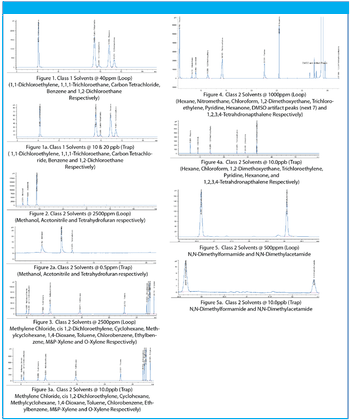
The Application Notebook
Residual solvents in pharmaceuticals are defined as volatile organic chemicals that are used or produced in the manufacture of drug substances, excipients or in the preparation of drug products. Because residual solvents do not provide therapeutic benefits, they should be removed, to the extent possible. Drug products should contain no higher levels of residual solvents than can be supported by safety data. Looking forward to the implementation of a revised USP <467> method, Teledyne Tekmar evaluated the new protocol, therefore this application will comply with the procedure and criteria changes set forth in the USP30 NF25, Second Supplement (effective December 1, 2007) and the interim revision announcement. (1)
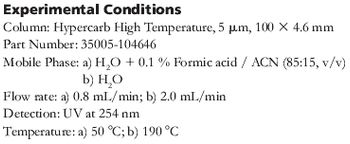
The Application Notebook
Increased temperature has been used to assist the elimination of organic modifier required in the mobile phase, to achieve analyte separation in pure aqueous mobile phases.

The Application Notebook
Melamine is an organic base and a trimer of cyanamide, with a 1,3,5-triazine skeleton. Melamine can react with formaldehyde to produce melamine resin, a very durable thermosetting plastic, and melamine foam, a polymeric cleaning product. Some end products made from melamine include countertops, dry erase boards, fabrics, glues, housewares, and flame retardants. Melamine is also one of the major components in Pigment Yellow 150, a colorant in inks and plastics.
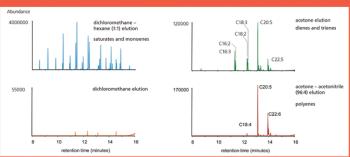
The Application Notebook
LC–GC approaches to analysis are particularly attractive because they combine the selectivity of solid phase sorbents in the first dimension with the separating power and peak capacity of a capillary GC column in the following dimensions. Their widespread use is limited because of the difficultly in desolvating the stream from the LC dimension without the solvent vapour passing down the GC column in significant quantity. An alternative approach to elution chromatography in the first dimension is to harness the specificity of the solid-phase process for digital chromatography using discontinuous changes in solvent polarity. Digital chromatography on a small sorbent bed reduces the volume of mobile phase to discrete plugs that are sufficiently small to be injected directly into a GC with a large volume injector or, alternatively, subsampled into a conventional split/splitless injector.
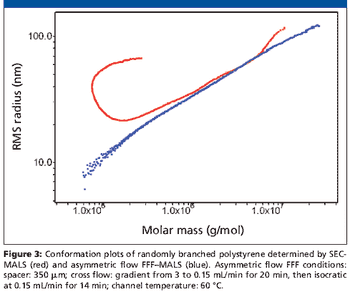
The Application Notebook
Recent development of the instrumentation for asymmetric flow field flow fractionation (FFF) brings new possibilities for the characterization of synthetic and natural polymers with several advantages over traditionally used size exclusion chromatography (SEC). The main difference of asymmetric flow FFF compared to SEC is that the polymer separation takes place in an entirely empty channel, which eliminates undesirable SEC effects such as shearing degradation of polymers with ultra high molar mass, anchoring of branched macromolecules in SEC column packing, and enthalpic interactions of polymer molecules with a stationary phase.
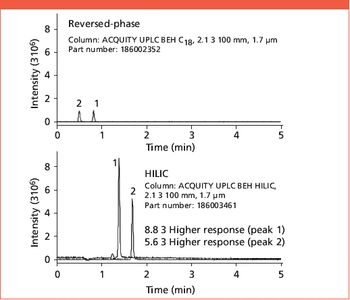
The Application Notebook
Using HILIC with highly efficient ethylene bridged hybrid (BEH) particles results in faster methods that exhibit improved polar retention, higher sensitivity, enhanced chromatographic resolution, and significantly improved column lifetime.

The Application Notebook
Forensic laboratories face a daunting task to identify trace amounts of controlled substances in small samples of seized evidence. Unambiguous identification is required to meet the stiff challenge that is sure to be raised in the courtroom. Positive proof is especially difficult to establish if the controlled substance is hidden in a complex food matrix with a high content of sugars, fats, fatty acids, proteins, and alkaloids.

The Application Notebook
To meet the growing need for fast reversed-phase enantiomer separations, two new 3-μm reversed-phase columns, CHIRALCEL® OD® -3R and CHIRALPAK® AD® -3R, have been introduced. High column performance and column stability under a wide range of conditions, including aqueous solvent systems suited to LC–MS, have been

The Application Notebook
LC–MS-MS instruments operating in Multiple Reaction Monitoring (MRM) are widely used for targeted quantitation on triple quadrupole and hybrid triple quadrupole linear ion trap (QTRAP® ) systems because of their well known selectivity and sensitivity. In MRM mode, the first quadrupole (Q1) filters a specific precursor ion; the collision cell (Q2) generates fragments (product ions) which are filtered in the third quadrupole (Q3). Although this double mass filtering greatly reduces noise there is always a chance that elevated background levels or matrix signals interfere with the targeted analyte.

The Application Notebook
The Pirkle - Type Whelk-O®1 CSP is a synthetically made chiral selector covalently bonded to a silica support. This phase is well known in the industry for its broad degree of generality, mobile phase compatibility, and ability to invert elution order. Most commonly used polysaccharide coated CSP's are sensitive to the presence of certain mobile phase modifiers such as DEA, TEA, and TFA. Retained memory effects can adversely affect a separation resulting in broad and tailing peaks, no peak elution, and reduced or loss of separation altogether. To remove these unwanted memory effects, the column must be rinsed with an alcohol, such as methanol or ethanol. This is a time consuming and costly process. The Whelk-O®1 CSP does not exhibit any such retained memory behavior.